This article was originally published on the web on thealpinegarden.com however that website is defunct at May 2015. The copyright is with the original owners of thealpinegarden.com
The Trough Garden
by Alan Grainger
 Growing plants in a trough is one of the most satisfying ways of viewing one's treasured alpines. Probably the most difficult aspect of this type of gardening, is finding the trough to start with.
Growing plants in a trough is one of the most satisfying ways of viewing one's treasured alpines. Probably the most difficult aspect of this type of gardening, is finding the trough to start with.
To introduce you to the way I became involved in Trough Gardening and to explain how this hobby has developed, let me take you back some 15 years and many plants ago..........................
When I first had the desire to plant a trough, my main problem was in finding one. Twenty five years ago, it was commonplace to find troughs lying in fields, having been discarded in favour of high-tech replacements. 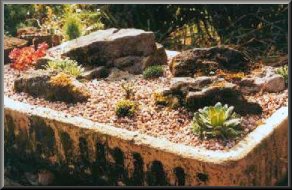 They could be had for the asking. Nowadays, however, the farmers have realised the value of these antiquities of the agricultural revolution and can make large amounts of money by selling them at auction. I don't know your feelings on this,but I prefer to spend my hard-earned cash on the plants rather than the containers and so, as a last resort, I decided to try to make my own.
They could be had for the asking. Nowadays, however, the farmers have realised the value of these antiquities of the agricultural revolution and can make large amounts of money by selling them at auction. I don't know your feelings on this,but I prefer to spend my hard-earned cash on the plants rather than the containers and so, as a last resort, I decided to try to make my own.
My first thoughts went to making solid ones of hypertufa in a wooden former but having made my first one of gargantuan proportions, I soon realised that my pain threshold was not as high as I had first thought. Time for a rethink.....Next I decided that I would cover an old glazed sink with a hypertufa mixture. These sinks were readily available so I put three in the boot (trunk) of my car. (You'll notice I am considering my American friends whilst writing this). Well folks, I don't know what you call your suspension system but I called mine some rather naughty expletives when it gave out on me under the weight........back to the drawing board again.
At the time all this was happening, we had something or other delivered to us in a polystyrene (styrofoam) box. It wasn't until I came to dispose of it, that it occurred to me that it reminded me of a glazed sink, but a hundred times lighter in weight and that if I could find a way of coating it with hypertufa, it would possibly make a container resembling a stone trough. My experiment proved successful and became the prototype for many others of differing shape and size.
Making the Trough
Firstly, obtain your polystyrene box. Consider even the smallest of them as there is usually space to be found for a small trough. Consider too, that they can be readily modified by glueing two, three or even four of them together. The possibilities are endless.
Next, make suitable drainage holes in the base of the box with a sharp knife or some such implement. I would normally make the holes around 25mm diam. and place them at 13cm intervals.
The basic ingredients for the hypertufa mix are readily available from garden centres, nurseries or builders supplies. They are:-
- Fine grade Portland Cement
- Gritty Concreting Sand
- Dark, Finely Sieved Peat
There are numerous blends one can use but I am convinced, having made over 30 of these troughs, that the best is:-
- 2 parts Sharp Sand
- 2 parts Peat
- 1 part Cement
The mixing is the most difficult aspect of the work to put into words but basically it is necessary to mix the ingredients dry so that a perfectly homogenous mixture is obtained. This is also why it is vital to use sieved peat. If any lumps are left in, they will not break down during mixing and will be seen all over the surface of the finished trough. In addition to being unsightly, these lumps will eventually decompose and fall out, leaving holes for frost to invade. You have been warned.
When a uniform mix has been achieved, begin to add water slowly, whilst stirring continuously. The mix needs to be "the wet side of moist." (To expand on this highly technical terminology, when a fistful of the wet mixture is squeezed, it should retain its shape without either oozing water, or falling apart. A bit like dumplings, if you will). When mixed correctly, it will remain workable for about thirty minutes.
An adhesive is required to give the hypertufa a key to the polystyrene surface. There are many adhesives on the market but only two types are suitable. They are
PVA (Polyvinylacetate) and EVA (Ethylvinylacetate)
These are readily available in the form of white woodworking adhesives such as Unibond and Evostik amongst others.
When mixing and applying the hypertufa mixture, it is important to wear protective clothing, i.e. kitchen gloves (Marigold or similar). The wet mixture will ruin your skin, fingernails etc. and the lime content in the cement can be an irritant.
Firstly, stand the box upside-down. Coat the bottom of the box and one quarter of its sides with the adhesive and then immediately apply the hypertufa to the coated area.This is contrary to the manufacturers recommendations but if you follow my instructions, a complete bond will take place between the three components. Apply the hypertufa by hand, moulding it like modelling plasticine. This will give the end product a 'natural stone' look. Pay particular attention to edges and corners. These usually need an extra thickness applied to prevent damage. I would consider a thickness of 15mm to be adequate, so 20mm on the edges and corners should suffice. The overall effect should look like stone that has been hewn out of rock. Allow this to dry overnight.
Next, turn the box the right way up, coat the rest of the sides, the top edges and at least 5cm down the inside of the box with adhesive and again, immediately apply the hypertufa. Do not worry about getting adhesive onto the previously treated parts, a brushing of the hypertufa over that area will soon cover up any excess adhesive. Leave the whole to dry for a minimum of 24 hours before planting - longer if you have the patience (but then what gardener does?)
Tips:
Only make sufficient wet mix for one session.
Don't be tempted to try to cover the whole box in one session. IT DOES NOT WORK
Be safe: Use protective clothing where necessary.
Advantages:
- The cost of obtaining the boxes is negligible
- You can fill the car without carrying too much weight.
- When finished, the troughs are a fraction of the weight of the real thing.
- .... and please, no offence intended here, but these troughs are ideal for ladies and the elderly, as they are lightweight and can be moved from place to place without too much effort, Because of their portability, it is possible to plant them with frost-tender plants which can be stood outside during fair weather and taken in during foul.
- The polystyrene core gives these troughs an excellent insulation property. This provides the roots with a much more stable temperature than is experienced in natural stone troughs, a benefit in both summer and winter.
- They make great gifts and raffle prizes at your local groups and chapters - (Ask Phyllis Gustafson of Oregon).
Disadvantages
The only real disadvantage, is that it takes a couple of seasons for the troughs to look "weathered".
Preparing the trough for planting
Ok, so you were impatient after all.....so what next? Here is a tip that not everybody knows but I find it works well. Line the bottom of your trough with fine Plastic netting, similar to the material you buy for shading at your local garden center. This serves two purposes,
- It stops the soil from running out of the drainage holes and
- It stops those horrible slugs from getting in from the bottom.
Having done that, lay a rotted turf, the size of the inside of the trough, face down onto the plastic netting. I would not dream of telling you what compost to fill your trough with because everyone likes to think that their recipe is the best. However, let me add a caveat. The compost will house these plants for 5 years or so and must therefore be of good sustenance and good drainage, whilst never drying out completely. So decide on the type of plants you want to grow and give them something suitable. On filling the trough with compost- and here's where more patience is required- overfill the trough as much as you dare and allow for settlement, because settle it will and if you just fill it to the rim, it will settle a good 50mm lower in 12 months. Having allowed the compost to settle, you can begin the next stage...........
Landscaping the Trough
The trough need not look like a mini-Eiger, but neither need it look like something devised by the Flat Earth Society. Careful planning can not only make it look very attractive but can also incorporate many areas of special interest and effect.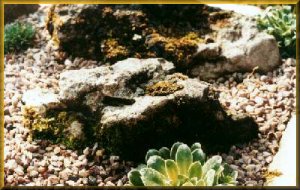
The majority of plants suitable for troughs would seem to require an aspect in full sun. Indeed, this is usually most beneficial. Not all plants however, relish sun-stroke and whilst it is not always possible to find a spot that can provide shade at the appropriate time of the day, it is possible with thought to use a suitably placed rock to provide shade on one side and sun on the other.
Rock in fact has more uses than providing shade. Two pieces placed closely together will provide a home for the finest crevice plants, pandering perfectly to the twin desires of a cool root-run and superior drainage. Several strategically placed rocks can also be used to simulate an outcrop, to give extra height to a larger trough.
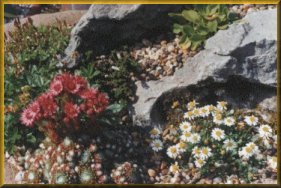 There are materials other than rock which are ideally suitable for landscaping troughs. For example, I have a trough which is planted with ericaceous plants accompanied by 'tree stumps' and 'logs'. These can be made from young prunings of shrubs and trees etc. and can be quite attractive if used correctly. Be sure though, to strip off all the bark from these bits and treat them with a non-toxic wood preservative.
There are materials other than rock which are ideally suitable for landscaping troughs. For example, I have a trough which is planted with ericaceous plants accompanied by 'tree stumps' and 'logs'. These can be made from young prunings of shrubs and trees etc. and can be quite attractive if used correctly. Be sure though, to strip off all the bark from these bits and treat them with a non-toxic wood preservative.
The top dressing need not be conventional chippings either. Any appropriate dressing can be used, as exhibitors demonstrate with their show plants. I would suggest that chipped bark, pine needles and slivers of slate can often provide a more pleasant ground covering for many plants and, of course, tufa was just made for the trough garden.
When landscaping the trough, pay particular attention to the needs of the plants that will find their home there. I have already suggested fabricating crevices and providing shade but remember the corners and use plants that will cascade over the edges. Mat forming alpines will also be useful on larger areas of uninterrupted surface. Dwarf shrubs and conifers are a 'must' for providing a focal point and supplying much-needed height to the flatter areas of the trough.
But please, before you dive headlong into trough-making, give it a lot of thought. There is no point in constructing something that will not provide a happy home for your plants. DON'T use water-worn limestone for ericaceous plants. DON'T put shade lovers in full sun, And DO remember that, above all else, the landscaping is secondary: THE PLANTS COME FIRST.
Planting the Trough
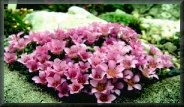 I have already mentioned Ericaceous plants for the trough. We naturally think of Rhododendrons in this context but, as pretty as they are, I would suggest you stay away from them for all but the largest troughs. Even the dwarfest rhodo will soon outlive its space in a trough. There are many other, more accomodating members of this family suitable for trough culture. Vaccinium vitis-idea var minus, Arctostaphylos uva-ursi var minor, Arcterica nana, Cassiope hypnoides and the many dwarf forms of Andromeda and Kalmia. Remember too, that many other plants associate well with members of the Ericaceae. These include shortias,celmisias and many of the asiatic primulas. A mixed planting including such items will help to give a colourful display over a much longer period.
I have already mentioned Ericaceous plants for the trough. We naturally think of Rhododendrons in this context but, as pretty as they are, I would suggest you stay away from them for all but the largest troughs. Even the dwarfest rhodo will soon outlive its space in a trough. There are many other, more accomodating members of this family suitable for trough culture. Vaccinium vitis-idea var minus, Arctostaphylos uva-ursi var minor, Arcterica nana, Cassiope hypnoides and the many dwarf forms of Andromeda and Kalmia. Remember too, that many other plants associate well with members of the Ericaceae. These include shortias,celmisias and many of the asiatic primulas. A mixed planting including such items will help to give a colourful display over a much longer period.
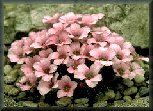 Lime-loving plants are perhaps the most suited of all to trough culture. Saxifragas will give possibly the widest choice of colour, form and foliage effect. The 'silvers' with their symmetrical rosettes of leaves edged with white lime deposits look magnificent, all year round, whether in flower or not. The 'porophyllum Saxifragas are superb from January through to April and there is a wide colour range from red, pink, yellow, apricot and every hue in between. Be careful not to place them in full sun though; when temperatures rise, the foliage will soon burn up.
Lime-loving plants are perhaps the most suited of all to trough culture. Saxifragas will give possibly the widest choice of colour, form and foliage effect. The 'silvers' with their symmetrical rosettes of leaves edged with white lime deposits look magnificent, all year round, whether in flower or not. The 'porophyllum Saxifragas are superb from January through to April and there is a wide colour range from red, pink, yellow, apricot and every hue in between. Be careful not to place them in full sun though; when temperatures rise, the foliage will soon burn up.
Dianthus is another genus that will thrive here; DD. erinaceus,microlepis, muselae and pavonius are good trough subjects. Try also the thrifts (Armeria sp.); the dwarf Columbines such as 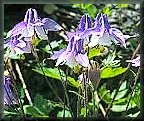 Aquilegia jonesii, bertolinii and discolor. The globularias; GG repens, bellidifolia and incanescens are thoroughly rewarding and the helichrysums, especially the silver rosetted
Aquilegia jonesii, bertolinii and discolor. The globularias; GG repens, bellidifolia and incanescens are thoroughly rewarding and the helichrysums, especially the silver rosetted 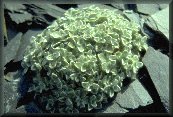 H.pagophilum a nd H.sessile will light up the darkest corner.
H.pagophilum a nd H.sessile will light up the darkest corner.
Crevice plants can be taken to include the saxifrages but consider too the European Primulas - minima, marginata, viscosa and integrifolia. Androsaces can also be used providing some shelter from winter rain can be provided. AA alpina, villosa jacquemontii and sarmentosa make good trough subjects.The choice Campanulas; 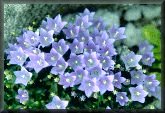 CC herzogovina nana and zoysii (beware of slugs) and their relatives Edraianthus will love the crevice conditions as too will the less vigourous Lewisia species. Exquisite plants such as Bolax gemmifera, Chionohebe densifolia and Ranunculus glacialis despite being difficult, will be especially satisfying, if successful.
CC herzogovina nana and zoysii (beware of slugs) and their relatives Edraianthus will love the crevice conditions as too will the less vigourous Lewisia species. Exquisite plants such as Bolax gemmifera, Chionohebe densifolia and Ranunculus glacialis despite being difficult, will be especially satisfying, if successful.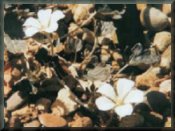
There are many fine dwarf shrubs that will cascade over the corners or edges to break the outline and extend the display downwards. Suggestions include the dwarf Cotoneasters, Potentillas and Hedera species. and the very dwarf Clematis such as marmoraria and x Cartmanii 'Joe'. Be warned though, only the less rampant ones will stand the test of time.....And speaking of Thyme, many of the smaller Thymus species will also brighten up a corner of a trough in the months of summer. Give space too, to the smaller Phlox, Arabis and Sedum species and cultivars. Of the latter, I would recommend Sedum acre var minus,which will stay compact for many years. The dwarf willows, Salix retusa and hylematica are excellent for cascading over a corner of the trough.
The finest of all ground cover plants for troughs are undoubtedly the smaller houseleeks-Sempervivum. They have character all the year round and come in hundreds of colours to match any planting scheme. A trough full of 'Semps' is a sight to behold. Some Antipodean members of the genus Scleranthus are the next best thing toAstro Turf. They look like grass, do not need mowing and will stay within bounds. Use them to simulate an alpine lawn on the flatter areas of the trough. Likewise, the mat forming Raoulia species and the splendid Gypsophila tenuifolia, which also looks lovely when in flower.
There are numerous dwarf shrubs  and dwarf conifers that will grace any trough but they must be the subjects of careful selection, or they will draw too much emphasis. They need to fit in with the scale of the rest of the planting and should never be planted in the dead centre of a trough. "Dead" being the operative word in the case of the Noah's Ark Juniper, ( Juniperus communis 'Compressa' ),
and dwarf conifers that will grace any trough but they must be the subjects of careful selection, or they will draw too much emphasis. They need to fit in with the scale of the rest of the planting and should never be planted in the dead centre of a trough. "Dead" being the operative word in the case of the Noah's Ark Juniper, ( Juniperus communis 'Compressa' ), 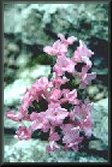 which will look like a cenotaph to the Unknown Alpinist. Off -centre and towards one corner, they are likely to look more natural. In addition to the juniper, I offer the following for consideration: Daphne petraea var grandiflora, Cyathodes (Leucopogon) fraseri, Kalmiopsis leachiana ( acid troughs only), Salix x boydii and Hebe tetragona.
which will look like a cenotaph to the Unknown Alpinist. Off -centre and towards one corner, they are likely to look more natural. In addition to the juniper, I offer the following for consideration: Daphne petraea var grandiflora, Cyathodes (Leucopogon) fraseri, Kalmiopsis leachiana ( acid troughs only), Salix x boydii and Hebe tetragona.
 With a little planning and a spirit of adventure, your trough can look good for many years without the need to amend the planting scheme. It will however take a little time to fill out the unplanted areas, so why not scatter a few of your spare seeds into the empty places between the plants, or in the narrower clefts in your rockwork. Something always comes up and it can often be more than a very pleasant surprise.
With a little planning and a spirit of adventure, your trough can look good for many years without the need to amend the planting scheme. It will however take a little time to fill out the unplanted areas, so why not scatter a few of your spare seeds into the empty places between the plants, or in the narrower clefts in your rockwork. Something always comes up and it can often be more than a very pleasant surprise.
I have only barely scratched the surface of the trough adventure. Given the room and the funds, you could carry on making and planting your troughs for years to come. So start soon, or even better....START NOW.
For a list of plants and planting schemes, don't miss our joint venture "Planting Schemes For Trough Gardens" which can be seen on both sites.